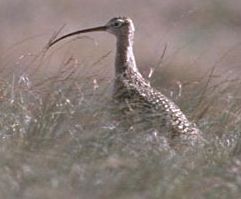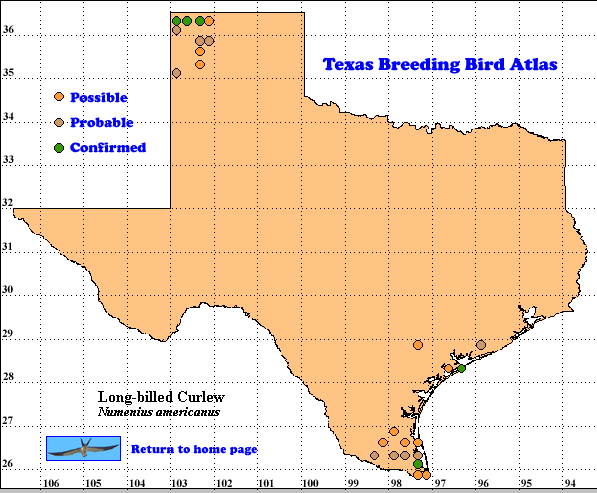The Long-billed Curlew formerly bred throughout the prairie regions of central North America as far east as Michigan, Illinois, and possibly Ohio (Bent 1929), but is now limited to the southern Canadian provinces south through eastern Washington and northeastern California, central Nevada, Utah, and northeast New Mexico on the west, and western South Dakota, Nebraska, southwestern Kansas, eastern Colorado, and northwest Texas on the east, occasionally breeding in the coastal plains of Texas (Am. Ornithol. Union 1998). Migrant curlews may be encountered over much of Texas with the exception of the forested areas in the eastern sector. In winter it is common on the coast and locally common on the South Plains (Lockwood and Freeman 2004).
DISTRIBUTION: Atlasers in 1987-1992 found Long-billed Curlews confined to the High Plains of the northwestern Panhandle and coastal prairies from the Coastal Bend south to the Rio Grade delta. Confirmed nesting was found in Dallam and Calhoun, (latilong 36102, quads C4 and D5-7), and Cameron (26093-A3) counties. Probable nesting was found in Hartley, Moore, Deaf Smith, Matagorda, Willacy, and Hidalgo counties., and possible nesting in Sherman, Oldham, Goliad, and Kenedy counties. Curlews observed in the southern Panhandle in Hall and Swisher counties during late June and early July were thought to be early migrants and ruled out as possible breeders. Perhaps some found in coastal areas and classified possible breeders should have also been ruled out, for many non-breeding curlews spend all year in their wintering areas (Hayman et al. 1986). Prior to the TBBA, field work in early June in Hartley County found curlews to be common with much nesting activity (KS).
SEASONAL OCCURRENCE: Curlews begin leaving their wintering grounds in mid- March, some migrants lingering on the Upper Coast as late as mid-May (Williams and WiIliams 1954). They arrive on their nesting grounds in the northwestern Panhandle in late March and early April, often paired. The breeding season on the High Plains extends from mid-April to early July. King (1978), whose observations encompassed both Dallam and Hartley counties in the Texas Panhandle and Baca County in southeastern Colorado, observed courting and copulation between April 12 and 15, nest-building April 18 and May 19, and incubation as late as June 23. A courting/copulating pair was observed April 16, 1996, and a nest containing four eggs on June 10, 1978, in Dallam County where dependent young were seen between June 11- 30 (KS). Oberholser (1974) cited nesting in Dallam County as late as July.
Published references to nesting in coastal areas are scant. Oberholser (1974) cited two dates: Harris County, 7 fledglings June 1, 1910; Cameron County (1 fledgling June 16, 1877).
During the TBBA field work, fledglings were observed in Cameron County July 11, 1987,4444 and July 13, 1990. Some curlews in northwest Texas begin leaving their breeding grounds as early as June, while others remain with their young and migrate later. Large flocks may appear in coastal areas as early as mid- to late July (Lasley and Sexton, 1989 and 1992).
BREEDING HABITAT. Nesting environments of the Long-billed Curlew in Texas range from short-grass to mid-grass prairies on the High Plains to moist meadow-lands and mowed areas (e. g., golf courses) in Coastal areas. In the Panhandle adult curlews use all vegetative types with the exception of sand-sagebrush, but use rangeland more than agricultural land, and in a relatively greater proportion than its availability (King 1978). Curlews make use of agricultural land in their foraging activities, occasionally placing their nests in fallow cropland. Unfledged young often hide in wheat fields when disturbed: A number of TBBA confirmed records were based on encountering adults engaged in alarm behavior and distraction displays at the margins of such fields. Many curlew observations (39%) occur within 0.4 km (1/4 mi) of standing water, including playas, stock ponds, and irrigation ponds and ditches. The presence of standing or intermittent water may be influential in the selection of nest sites (King 1978). The nest is a mere hollow lined with grasses and forbs, often placed near dried cow dung. There is a tendency for birds to nest in loose colonies within sight of one another. Amazingly for a bird so large, an incubating curlew stretched full length on its nest can remain hidden from view until almost stepped on. Atlasers regarded the discovery of a nest a matter of luck.
STATUS: Breeding Bird Survey routes that record curlews all lie within the Panhandle area. The Texline route in Dalham County had the second highest national average annual total, 41.6 curlews (Price et al. 1995). None have been recorded on the coastal routes. Although a permanent resident on the coast to Galveston Bay (Lockwood and Freeman 2004), few curlews nest. Nesting on the Upper Coast is considered “occasional” only (Dauphin et al. ,l989), and it is “questionable” any currently do. Nesting in the Coastal Bend area also is thought “occasional” (Rappole and Blacklock 1985), while in the Delta it is “accidental” (H. Burgess and B. Ortego, pers. comm.). But see the TBBA map below showing 1 confirmed and numerous probable records in latilong 26097.
The long-term North American Breeding Bird Survey trend of the Long-billed Curfew in Texas shows a statistically significant -3.8%/year change from 7 routes over the period 1966-2005 and a -4.9% change for 1986-2005 (6 routes). The 1966- 2005 data for the 266 routes in the United States and Canada produced a less worrisome 95% confidence interval of -2.9 to +0.4% population change per year (Sauer et al. 2005).
The trend data and decline in breeding range indicate the breeding population of Long-billed Curlews is continuing to decline in Texas at a rapid rate, although it will continue to be present as a migrant and winter resident.
Text by Kenneth D. Seyffert (Posted with updates 2006)
Literature cited.
American Ornithologists’ Union. 1998. Checklist of North American birds, 7th ed. Am, Ornithol. Union, Washington, DC.
Bent, A. C. 1929. Life histories of North American shore birds (Part Il). U. S. Nat. Mus.Bull. 146. Washington, D.C.
Dauphin, D. T., A. N. Pettingell, and E. R. Rozenburg. 1989. A birder’s checklist of the Upper Texas Coast. Ornithology Group, Houston Outdoor Nature Club.
Hayman, P., J. Marchant, and T. Prater. 1986. Shorebirds: an identification guide. Houghton Mifflin Co. Boston, MA.
King, R. 1978. Habitat use and related behaviors of breeding Long-billed Curlews. Master’s thesis. Colorado State University, Fort Collins. 69 pp.
Lasley, G. W., and C. Sexton. 1989. Texas region. Am. Birds 43: 1337-1342.
Lasley, G. W., and C. Sexton. 1992. Texas region. Am. Birds 46: 1153-1156.
Lockwood, M. W. and B. Freeman. 2004. The TOS handbook of Texas birds. Texas A&M University Press, College Station.
Oberholser, H. C. 1974. The bird life of Texas. University of Texas Press. Austin.
Price, J., S. Droege, and A. Price. 1995. The summer atlas of North American birds. Academic Press, New York.
Rappole, J. H. and G. W. Blacklock. 1985. Birds of the Texas Coastal Bend: abundance and distribution. Texas A&M University Press. College Station.
Sauer, J. R., J. E. Hines, and J. Fallon. 2005. The North American Breeding Bird Survey, results and analysis 1966-2005. Version 6.2 2006. USGS Patuxent Wildlife Research Center, Laurel MD < http://www.mbr-pwrc.usgs.gov/bbs>
Williams, G. G. and S. G. Williams. 1954. South Texas region. Aud. Field Notes 5: 265-266.

